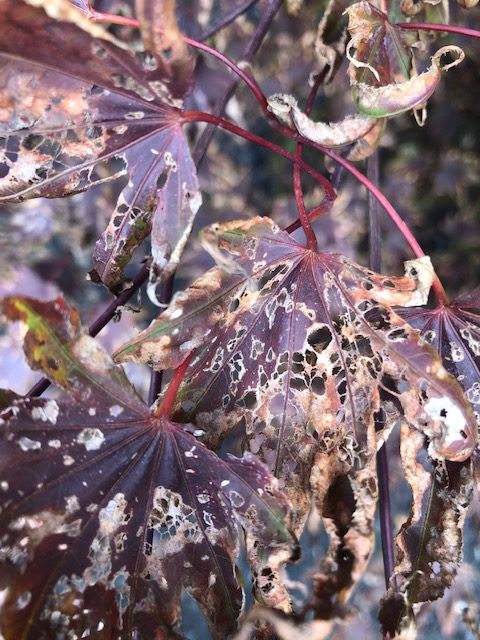
WE have two japanese maples in our front garden that appear to be ailing this year. It is fairly windy here but the trees typically are very healthy. We don’t see any insects on the leaves but it appears something is eating them and the leaves are curling slightly and dying. Please see pics. for help. Thank you
Thank you for contacting the Toronto Master Gardeners concering your ailing maple tree.
From your photo it appears that your Japanese maple is being attacked by Japanese beetles. These insects can be identified by their metallic brown to copper wings tinged with green and are seen hanging out on the leaves early in the morning or evening. Japanese beetles are an annoying pest that attacks a whole variety of plants on warm sunny days. The Ontario Ministry of Agriculture and Food has a website at the bottom of which there is a lists of plants that are most susceptible to damage by this insect an unfortunately Japanese maple is one of those plants.
Japanese beetles lay their eggs in the soil under lawns. The larvae will overwinter in the soil and continue feeding as the weather warms in the spring. Once the larvae are full grown, they will pupate and emerge as adults in late June and early July. The adult beetle will continue to feed on foliage through July and August.
The following information on controlling this pest is from an earlier post on our website:
“To control Japanese beetles you can either control the adult or the larvae. The best method (although still time consuming but strangely satisfying) is to go out in the early morning or in the late evening when they are not as likely to fly around and simply knock them into a small bucket/jar of water (add a few drops of soap) where they will drown. You will need to begin this process at the end of June or the beginning of July and continue until sometime in early August.”
This year I happen to notice that the infestation did not begin in large numbers until the end of July and it is still going strong. Most of my roses as well as perennial hibiscus, Rose of Sharon and Wisteria vine are currently providing a nice meal for these voracious beetles. You will find me outside morning and evening with my bucket of soapy water collecting these nasty pests. If you have a lawn surrounding your Japanese maple you could try controlling the larval stage with the application of beneficial nematodes to your lawn in late summer. Nematodes are a type of roundworm that feeds on grubs. Be sure to select a type of nematode specific to the larvae of Japanese beetles, and to apply as per manufacturer’s instructions.
“Nematodes are best applied in August and are watered into the affected area. They attack the larva of Japanese beetle, June bugs and European chafer all of which racoons and skunks like to dig up the lawn in search of. When applying nematodes it is important to keep them refrigerated until you are ready to apply them. Ideally they should be applied on an overcast morning or evening. If the lawn is dry it should be irrigated first with about ½ to 1 inch of water. You should prepare and use the entire pack and water (while agitating) them into the soil. You might need to irrigate the lawn again to “wash” the nematodes into the soil.”
The curling and drying of the leaves could be a result due to leaf scorch or improper watering. Watering deeply and less often is vital especially if it is growing in full sun. Mulching around the base of the tree will also help retain soil moisture but make sure the mulch is kept 3-6 inches away from the tree trunk. For some general advice on the care of Bloodgood Japanese Maple, the link below has some good information from the Missouri Botanical Garden.
Good Luck with your Japanese Maple.

